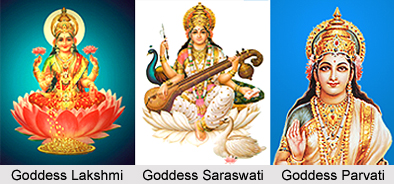 As per a popular legend Lord Vishnu had three wives: Goddess Saraswati, Goddess Lakshmi and Goddess Parvati. However, finding it difficult to manage three wives Vishnu gave Saraswati to Lord Brahma, Parvati to Lord Shiva, and retained Lakshmi for himself. According to Shiva Purana, goddesses Saraswati, Lakshmi and Parvati represent the three gunas Rajas, Sattva and Tamas respectively
As per a popular legend Lord Vishnu had three wives: Goddess Saraswati, Goddess Lakshmi and Goddess Parvati. However, finding it difficult to manage three wives Vishnu gave Saraswati to Lord Brahma, Parvati to Lord Shiva, and retained Lakshmi for himself. According to Shiva Purana, goddesses Saraswati, Lakshmi and Parvati represent the three gunas Rajas, Sattva and Tamas respectively
Goddess Saraswati
Goddess Saraswati, known and worshipped as the goddess of learning, music and arts, is popularly regarded as the consort of Lord Brahma. However, according to some icons north India, Lakshmi and Saraswati are regarded as the two consorts of Vishnu. In South India Shri (Lakshmi) and Bhudevi (Prithvi or Earth personified) are represented as the consort of Vishnu.
Goddess Lakshmi
Goddess Lakshmi, venerated as the goddess of wealth, is regarded as the consort of Lord Vishnu. The goddess has incarnated as his consort in different forms when the Lord has appeared on earth in his various avatara forms. When the Lord incarnated as Lord Rama, the goddess accompanied him as his holy consort Sita and when he descended as Lord Krishna she accompanied as his wife Rukmini.
Lakshmi also referred to as Shri evolved out of the Ocean of Milk during Samudra Manthan when it was churned by the devatas and the demons to extract amrita. Sitting on a lotus she emerged out of the Ocean with the two celestial elephants pouring milk over her on both sides. This representation of the deity is known as Gajalakshmi.
Shri or Lakshmi has been a popular deity portrayed in different forms such as, Dhana Lakshmi (goddess of corn); Bhoga Lakshmi (goddess of pleasure); Rajya Lakshmi, (goddess of royalty) and Vira Lakshmi (goddess of valour). Several exquisite Mauryan sculptural works depict Lakshmi`s idols.
Shri is worshipped as the goddess of beauty, prosperity and good luck. According to Vishnu Purana the deity has been represented as the mother of the world, eternal and omnipresent.
Bhudevi
Bhudevi is the second consort of Vishnu and associated with Varaha avatara. She is depicted standing or sitting on one side of Vishnu, while Shri occupies the other side.




















